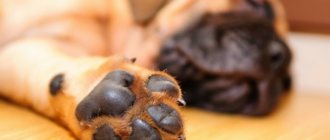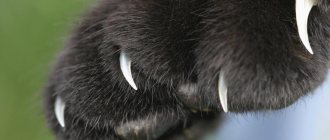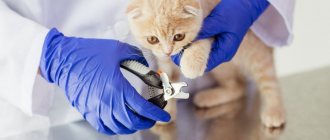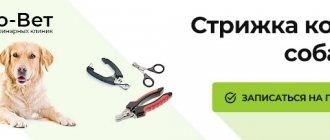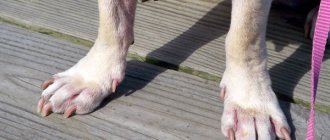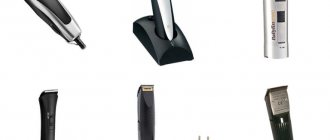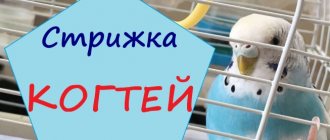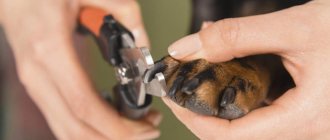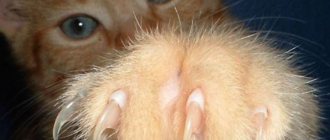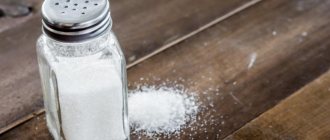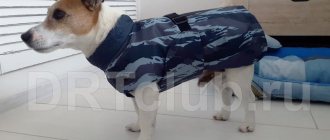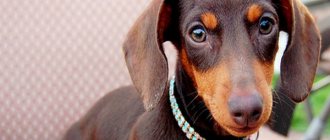Anatomy of a dog's claws
Before trimming, it is important to study the structure of the claws and features.
Each dog has its own form of horn formation:
- cat and dog - curved;
- hare - long, straight, sharp.
The claw itself consists of three parts:
- Roller and gutter. This part is covered with a thin wax-like skin. From below, the cushion practically merges with the fingertip; from above, it can be felt very well. The groove is a groove on the sides along the entire length of the claw, formed by the folds of the skin. The pulp corresponds to its size.
- Wall and rim. This is the visible part of the claw.
- The underside is partially covered with skin.
Expert opinion
Anna Abramenko
An avid dog lover. Experience in veterinary medicine since 2009.
Ask a Question
It is important to consider that, unlike human nails, a dog’s claw is “living” and sensitive. This is a protective shell for the nerve bundles and blood vessels that make up the pulp.
Natural stitching
Do I need to trim the nails of a dog that walks on asphalt a lot? Will they return to normal on their own? It is important to understand here that the claws wear down naturally, but this may not be enough, and besides, there is less grinding on the front paws. If you do not trim at all, the body of the claw (and the blood vessel inside it) will grow so large that trimming it will no longer be useful. This means that you can only hope that nothing bad happens, and if something happens, contact a veterinarian as an emergency. To prevent this, you need to think about your pet in advance and take care of the acceptable length of its claws.
What happens if you don't trim your dog's nails?
Failure to properly care for a dog’s nail plate leads to problems with its health.
The most common of them:
- deformation of joints and bones of the limbs;
- ingrown claws, leading to injury and the spread of inflammatory processes;
- lameness, problems with the spinal column, skeletal curvature;
- pain when walking;
- the appearance of wounds on soft tissues, their possible infection, suppuration of the paw;
- blood poisoning.
Additionally, long claws bring discomfort to the owner: in the house, a dog, trying to sharpen them, damages furniture, things, floors, and causes material damage.
How to determine the location of the cut
- If your puppy has light-colored nails, you will be able to see a pink line of blood vessels running through each nail. The cut should extend 1–2 mm to the beginning of the “pulp”.
- Black claws are almost invisible, so it is recommended to cut off only the ends to the bend.
Important! Don't forget to shorten the nails on the puppy's fifth toes (located above the hand). It is these claws that often have to be removed due to ingrowth and inflammation. In addition, a claw that is too long can get caught on any surface, causing injury to the finger.
Stages of the procedure
To properly trim your dog's nails at home, you should follow the instructions.
First you need to treat the instrument using sterilization, alcohol, antiseptic or boiling water. Even if it is new, from the factory packaging. Wash your hands with soap, treat with an antiseptic, and wipe. The correctness and safety of the procedure depends on cleanliness. If there is infection, inflammation, or wounds on your hands, it is better to postpone the haircut or entrust it to a professional.
Wash with clean water and dry the dog's paws. Carefully examine the claw plate and determine the location of the cut. It's easier to do this if the dog's nails are beige or brown. Black ones will be more difficult to cut. To identify the pulp, you can use a bright flashlight or contact your veterinarian. For better access to the claws, you can press on the dog's toe pad.
The tip that needs to be removed is usually lighter and is 2-3 mm. It is better to do this consistently, so as not to cause pain and discomfort to the pet, or accidentally touch the pulp.
It is darker in color, filled with blood vessels and nerve bundles. A careless approach to this procedure may result in injury, pain and stress to the dog, and damage to nerve endings.
If the fur on the paws interferes with inspection, it is trimmed with safety scissors with rounded ends. Additionally, this measure will remove the area of accumulation of dirt and possible infection. If there are minor damages, calluses and cracks, they need to be treated.
Expert opinion
Anna Abramenko
An avid dog lover. Experience in veterinary medicine since 2009.
Ask a Question
If there are kinks, fungus, or significant damage to integrity, you should contact a veterinarian. Injured plates are not cut so as not to aggravate the animal’s condition. Using a special file, the claws are filed.
To start the procedure, you should give the dog the “Paw” command and take it in your hand, securely fix it, praise him for the correct execution, and reward him with a treat. Breeds of decorative dogs and small animals can be picked up.
Place large pets on the floor, and you will need an assistant and a leash. The partner should firmly grasp the animal by the neck and support the paw. During the procedure, it is important to remain calm, confident, and speak kindly and affectionately to the dog. To create a good mood, you can stroke it.
Expert opinion
Anna Abramenko
An avid dog lover. Experience in veterinary medicine since 2009.
Ask a Question
If the dog is nervous, bites and breaks out, it is recommended to postpone the procedure until later. The fear that arises can lead to sad consequences - the dog will stop trusting the owner, and the process of trimming its claws will become real torture for it.
The front paws should be treated first. When the procedure is completed, you can move on to the hind limbs after a 3-hour break, if the dog is friendly. This manifests itself in the absence of aggression and stress. First, it is advisable to treat the fifth claw, located above the others.
At the initial stages of accustoming to the procedure, the claws on the hind legs are trimmed while the dog is lying on its side. With experience, this can be done standing. So that she is not afraid, you should let her sniff the tools - specialized nippers, scissors, files.
Then make a cut with a nail clipper, placing it at an angle of 45 degrees. The size of the plate to be cut should be 0.3 cm smaller. Then sand the cut area with a nail file until smooth and to the desired length. This procedure will prevent delamination and achieve the correct shape of the claw.
Black horny formations need to be trimmed more slowly, 0.5 mm per step. If a lighter or pinker cut appears, you should stop to prevent the dog from damaging the pulp. If a plate is injured, you can use the tips from the “Treatment and Prevention of Wounds” section.
When the trimming process is completed, you need to praise your pet and give him a well-deserved treat.
If nail trimming is being done for the first time, you should not try to trim all the nail plates at once. This must be done systematically - 1-2 pieces at a time. Over time, the pet will get used to it, and the procedure will become faster and easier.
Frequency for adults – every 4 weeks, for puppies – 1.5 months.
How to trim nails
Proper nail trimming
Beginner dog breeders are advised to first look at how and with what tools animals’ nails are trimmed. This can be done by visiting a veterinary clinic or grooming salon, where the doctor will quickly and skillfully perform the trimming. It’s a good idea to find out in advance how much it costs to trim a dog’s nails, since prices for this service vary from 150 to 450 rubles in different institutions. Considering that an excellent quality nail clipper for large breed dogs costs about 600 rubles, it is more profitable to trim your pet’s nails at home.
You can sharpen the claws with a grinding machine.
When starting to trim, you should know that there are blood vessels and nerves running inside the claw, damage to which leads to severe pain and bleeding. An animal, once experiencing unpleasant sensations, will be afraid of any manipulation with its paws, run away and break free. This is why it is so important to always be as careful as possible when making cuts of a few millimeters. You can tell when to stop pruning by looking at the dark dot in the middle of the cut. It signals that the vessels are already close.
Experienced dog breeders know that the procedure is simpler and easier after washing the animal, since the nail tissue becomes softer and more pliable.
If your pet absolutely does not want to have its nails trimmed (the dog is afraid of the click of a nail clipper or has had a negative experience with a painful procedure), you can file the claw. For this purpose, a regular rasp is suitable, which is used to cut down dead tissue. Despite the duration of the procedure, many dog owners practice it as more gentle on their pet.
Required Tools
Before trimming and grinding claws, it is important to prepare the tools - sterilize them, treat them with alcohol, an antiseptic solution, or pour boiling water over them.
You will need the following set:
- nail clippers of various modifications;
- files with hard coating;
- hemostatic agents;
- antiseptics.
Ordinary scissors cannot be used, only as an auxiliary material for removing hair that interferes with the inspection of the paws.
For small breeds, miniature individuals, for example, Jack Russell puppies, a nail clipper with a limiter or a guillotine with holes for the nail plates is suitable.
It is better to cut a large dog using special clippers with sharp blades made of steel or brass. They should be treated with chrome on top. Without a protective coating, the tool quickly rusts and deteriorates.
To stop bleeding, use talc or baby powder, or, if they are unavailable, use flour. When treating wounds, use cotton pads or sterile swabs with iodine, peroxide, and potassium permanganate.
It is important to prepare a treat to praise your pet: if he followed the command correctly, wait patiently for the pruning to reward him.
Preparatory stage
Our main weapon
It is necessary to prepare in advance for trimming nails so that during the process you do not have to run after one after another, once again stressing the dog out. All tools and first aid items (you never know what will happen) should be stored in a separate plastic box.
What to keep on hand:
- a guillotine-type nail clipper with rubberized metal handles so that it does not slip in your hands;
- regular nail file;
- cotton pads;
- antiseptic (alcohol, chlorhexidine, hydrogen peroxide);
- hemostatic agents: talc or potassium permanganate powder (preferably in a bottle for ease of use).
It is not recommended to use tools (scissors or tongs) from a manicure set to trim claws: they do not cut, but shred, and the claw crumbles, flakes, burrs form, and the animal becomes even more angry from the prolonged “execution.”
Treatment and prevention of wounds
In order for the procedure to take place without pain and injury, it is necessary to prepare the dog mentally, give it sedatives based on herbs to dull nervous excitability. A hyperactive dog can be medicated and placed on a leash.
If the pulp is injured, bleeding may occur.
To stop it, you will need special wipes, talcum powder, baby powder or regular flour. Damaged skin should not be treated with fucorcin, alcohol solutions, iodine or brilliant green, as this will bring additional pain and stress to the pet.
If a dog jerks its paw while trimming its claws and the plate explodes, it is necessary to calm it down and distract it. In the area of the metatarsus, grab it with gauze or a bandage and secure it well.
To relieve swelling, pain, and stop bleeding, apply ice, frozen meat or other cold, wrapped in cotton or cellophane. For open ruptures, you can use pharmaceutical preparations - a solution of lidocaine or novocaine as a lotion, and then visit a veterinarian.
In case of any injury, cutting the claws further is not recommended. You should also not allow your dog near water to avoid infection.
Haircut technique
The dotted line shows the correct cutting line
The dog must be in excellent spirits; an excited or frightened dog should not be subjected to the procedure. This rule also applies to the owner. Additionally, he must exude confidence. If the owner is afraid of causing pain, although the process is absolutely painless, then it is worth seeking help from a specialist (veterinarian or groomer).
The animal is placed on a flat surface (table, couch, floor) or placed on your lap. The paw, depending on the position of the body, is carefully pulled forward or pulled back, the finger of the left hand is pressed on the pad, the claw is lengthened, and with clear, confident movements of the right hand, the excess is cut off at an angle of 45 towards the inside of the foot. Use a file to polish the tip, making it smooth.
How to use a nail clipper
Repeat the procedure once every two to three weeks.
How not to cut off excess?
A look from the inside: the pulp of the claw is indicated in red - this is what we try not to touch.
Under no circumstances should you cut by eye, otherwise you may injure the vessel. Knowledge of the anatomy of the claw will help to avoid bleeding: on the outside there is a thick layer of keratinized epithelium, inside there are blood vessels and nerves enclosed in a special sheath - the claw bed or pulp.
They cut, retreating a couple of millimeters from the pulp.
In dogs with light-colored claws, this area of living tissue is clearly visible to the naked eye. In dark-colored animals, they act carefully, biting off the claw little by little; As soon as a dark dot appears in the center of the area, the procedure is stopped.
If your hand trembles
Anyone can touch a blood vessel: both an experienced groomer and a person without skill. There is nothing fatal about this. The wound is immediately treated with any antiseptic and pressed for a few seconds with a cotton pad with potassium permanganate sprinkled on it. If there is severe bleeding that cannot be stopped on your own, the animal is urgently taken to the clinic.
Accustoming to the procedure
An immutable truth: learning begins from the cradle! Classes are conducted daily in a playful and friendly manner so that the puppy trusts you. If something doesn’t work out, the lesson is briefly interrupted and continued next time.
Sequencing:
- The dog should get used to the sight and sound of the nail clipper - this will help him understand that the tools do not pose a threat. To do this, first start by simply “shredding” something in her presence, for example, a soft pencil.
- Only after this do we move on to the next stage: trim the fur on the paw in the area of the toes. If the baby behaves well, we reinforce calm behavior with a treat; if not, we let him go and ignore him for a while.
- You can proceed directly to cutting: cut off the very tip of one claw, encourage. At first, you should not try to trim all the claws at once - this can frighten or anger your pet.
By and large, the entire learning process can be reduced to five small rules: training from childhood, careful actions in the process, close emotional contact, frequent haircuts and encouragement.
This is how we remove everything unnecessary from between our fingers
And in conclusion, a little advice: before cutting the nails of shaggy breeds (such as Pomeranians, poodles - in fact all small breeds except smooth-haired ones), all long hair on the pads, toes and between them is also cut off, this will improve visibility and make the whole process much easier .
Caring for a dog’s nails, and especially a puppy’s, is not just a cosmetic procedure. This should also be done for the pet’s health, because regrown tissue leads to unpleasant consequences, including purulent inflammation.
At risk are decorative individuals (, and others) that are not taken out for walks every day. How to trim a dog's nails at home? More details on how to perform the procedure in the material below.
You should start caring for a dog’s claws from an early age, while the pet is still a puppy, because its claws, although thin, are sharp: they can injure the bitch when feeding. And if the baby finds it uncomfortable to move due to overgrown claws, this will lead to incorrect placement of the paws or even dislocation.
Inside the claw of animals there is a pulp consisting of blood vessels and a bundle of nerves.
Important!
Do not damage the pulp! This will cause your pet severe pain. If damage does occur, it is immediately noticeable - the claw bleeds.
How often should you cut your dog's nails? On average, paws need to be treated once a month. However, the frequency will vary depending on the conditions in which the pet lives.
And if he often walks on the asphalt, the claws wear down on their own. If not, you can’t do without a haircut.
A reliable indicator that the time has come is the clicking of claws on the floor.
This is a sign that your pet is uncomfortable walking. And there is no need to wait, succumbing to the fear of causing pain. Neglecting paw treatment has bad consequences.
What happens if you don't cut your hair? If you delay processing, they will become too long, sharp, and bent.
For a dog this means the following:
- the claw wounds the skin until it bleeds, in this case an infection can enter the animal’s body, there is a high risk of developing purulent inflammation, and this can lead to blood poisoning, tissue necrosis, after which - amputation of a finger or even the entire paw;
- with such wounds it is painful to move, the gait changes, and as a result, posture is disturbed, coordination is lost, and muscle tone decreases;
- the pet injures itself and upon contact may, unwittingly, injure adult owners or children;
- a much less serious drawback: the dog will damage the floor or furniture while trying to sharpen its claws.
Attention!
When treating paws, we must not forget about the dewclaws: dogs often get caught on something with them, and this leads to injuries.
Since these toes do not touch the ground, it is difficult for your pet to grind down their claws.
Where is it better to carry out the procedure: at home or in a veterinary clinic?
The choice of place for the procedure depends on the nature of the animal, the skills and mood of the owner.
If you don’t have enough experience yet, you can call a veterinarian at home. This will allow your dog's nails to be trimmed professionally, without unnecessary stress for the dog.
Expert opinion
Anna Abramenko
An avid dog lover. Experience in veterinary medicine since 2009.
Ask a Question
Your pet may not like a visit to the veterinary clinic - he will be afraid, nervous, and pay attention to other animals.
Choosing a tool
The tool for cutting must be chosen in specialized stores: ordinary scissors are not suitable for the procedure. But don’t rush to put them off: they will come in handy in the process of preparing for the main procedure.
Main types
There are three types of dog tools:
- nail cutter in the form of pruning shears (one blade is straight, the second is curved);
- in the form of a guillotine (a device with a hole and a lever that raises the blade);
- electric claw sharpener (handle and rod for attachment with grinding stone).
The third option has more disadvantages than advantages: it makes a lot of noise, which can scare the dog, and when rubbed, the surface of the nozzle gets very hot.
The advantage of the tool is that it grinds and does not cut, that is, it is safer.
In addition to the main tool, you need to purchase a file to remove sharp edges after cutting.
Criterias of choice
Let's figure out how to choose a nail clipper for dogs.
The tool should be durable and well-fastened, the blades should be made of steel or brass so that they are less likely to become dull. The base metal should have a stainless coating to minimize the risk of infection.
The handles are rubberized (they won’t slip), the shape is comfortable for the owner’s hand, the tool needs to be felt in the hand.
Pay attention to the size of the nail clipper: they are available for both large dogs and miniature ones.
Possible problems
The ideal time for the procedure is after feeding or a long walk, then the dog is obedient, trusts without boundaries and is calm. However, trimming the nails itself can cause discomfort in the dog.
At the same time, she breaks free and tries to bite or run away. To prevent this from happening, you need to hold her well, talk gently and distract her with her favorite toys and treats.
From a young age, a puppy can be accustomed to this manipulation, doing everything gradually. At first, just familiarize him with the tools, next time additionally examine the claws, and another day try to cut them. If the dress rehearsals were successful, you can pick up the nail clippers and familiarize the animal with them.
When grooming a dog, it is important to trim and file its nails. The correctness of the procedure will allow you to avoid negative consequences and injuries, and will preserve your pet’s physical and mental health.
Dog nail trimming
Excessive growth of claws can lead to unpleasant consequences both for the owners and for the dachshund itself - if a claw breaks off, an infection can enter the wound and inflammation can begin. The risk increases if the dachshund is often outside without a leash - getting into the mud and walking through puddles. The answer to the question “do dogs have their nails trimmed” is clear – this must be done, because unkempt claws can grow into the flesh of the paw, causing discomfort and even pain to the dog. This may affect the movements of the four-legged friend, who will limp, and puppies with an insufficiently strong skeleton may even develop incorrect paw placement.
If inexperienced dog owners are concerned about whether dogs can have their nails trimmed, they should consider this: There is a risk that a particularly long nail could come off, injuring the animal's limb. The length of your dachshund's nails should be reduced to prevent this. Overgrown claws make movement difficult, clinging to roots and stones outside, and to carpets at home. By scraping across the floor, they damage it, leaving noticeable scratches on laminate and other coverings. By the way, if your pet doesn’t spend much time on the street or the walks are not on asphalt, the procedure for trimming the nails should be carried out more often, because they won’t be sharpened arbitrarily. The characteristic clicking sound when the dog moves will tell you when it’s time to shorten the nails.
How to cut a dog's nails
The procedure is carried out in 3 basic stages: preparing the pet, choosing a tool and directly processing the claws.
Preparation
If your pet is trained to trim its nails from a young age, there will be no problems with its training. However, such a situation is rare. Usually dogs either have a negative experience or are simply worried when they notice their owners’ preparations.
How to cut a dog's nails if he won't let you? In such cases, she needs to be calmed down, and this can be done like this:
- lay out the tools, let the pet sniff them, and then praise him and stop there;
- touch the dog’s claws with a tool, but do not cut them, and also praise it and treat it with a treat;
- repeat this positive reinforcement at each stage until the pet calms down completely.
If nothing helps to calm the animal, it is secured on a short leash and a muzzle is put on.
But the stages of preparation at the physical level are different:
- examine the claws, and if a fungus is found, contact a veterinarian, and if there are cracks or breaks, then you should not cut them, but file them;
- examine the pads to ensure they are free from abrasions and cuts, and when they are present, be careful so as not to cause pain;
- wash your pet’s paws well, but do not need alcohol or other antiseptic;
- If the animal has long hair, you will have to trim the fur between its toes and near the claws.
In addition, the timing of the procedure is also important. During those hours when the dog is tired, she is in a bad mood, she is sad, there is no need to do anything, and it is better to wait for a more positive state.
Tool selection
You cannot carry out the procedure with ordinary scissors or nail clippers, because dogs’ claws are much stronger and thicker than human ones and will peel off after using the scissors. You need suitable tools - nail clippers. They come in two types:
- ordinary scissors, externally resembling pruning shears, i.e. one blade is straight and the other is curved;
- guillotine scissors with a claw hole and a lever handle.
When choosing a nail clipper, you need to pay attention to:
- material that must be rigid and strong, i.e. brass or steel, and the instrument itself is ideally cast;
- processing of blades, because if they are not coated with chrome, they will quickly rust;
- handles must be rubberized, otherwise the tool will slip in the hand, and this will increase the risk of injury to the animal;
- size, because the tool is designed to be either , or , or .
In addition to the nail clipper, you will need a nail file with a hard coating.
It is also chosen depending on the size of the pet.
Treatment
How to trim a dog's nails? The first thing to do is to look closely at the claw tissue. They can be white, brown or beige, in which case it will not be a problem to see the pulp. If they are black, you won’t be able to see anything, and you’ll have to cut them at random. In this case, you need to remember that black claws are cut 0.5 mm at a time.
Important!
If the cut of the claw changes color, turns pink or becomes lighter, it means that the pulp is close and you need to stop so as not to damage it.
The actual cutting of the claws is carried out according to the following algorithm:
- You need to start with the front paws
, inspect them, and cut off the hair if necessary. - Place the nail clipper blades one and a half millimeters below the pulp and cut at an angle of 45 degrees.
- You need to cut confidently and quickly; hesitation is inappropriate here.
- The cut is processed with a nail file to blunt the sharp edges.
- During the treatment of the hind legs, the dog should be placed on its side, but once it gets used to the procedure, this can be done in a standing position.
After each “step” the pet should be praised, and between “steps” it is advisable to leave a gap of 2-3 minutes so that the animal can rest and calm down. And if the dog becomes nervous during the procedure, it should be stopped immediately.
Attention!
The hind paws are not treated immediately after the front paws, but after 2-3 hours. Not earlier.
Manicure salon: how, when and with what to cut a puppy’s nails
The procedure for trimming puppy nails is very important in caring for your dog. It is connected not so much with the need to make your pet’s paw beautiful, but with concern for the health of the animal. The fact is that too long nails can cause infection in the dog’s body. They also interfere with the formation of correct gait and affect the tone of the paw muscles.
A puppy's nails need to be trimmed once a month on average. This can be done more often or less often, depending on the individual physiological characteristics of the animal and the conditions of its detention. The main thing is not to wait for the pet to start clicking its claws on the tiles.
It is very important to pay attention to the claws located on the side toes of the puppy's paw. They do not wear off naturally due to their location (on asphalt, tiles) and can grow into the soft tissue of the paw and cause the animal to limp. Sometimes this problem can lead to more serious consequences, such as blood poisoning.
Nail clippers should have handles made of strong plastic. But, most importantly, they must be well sharpened. It is better to choose imported tools (Germany, Czech Republic). Although from time to time there are also high-quality domestically produced wire cutters on sale.
Inside each puppy claw there is a blood vessel that grows
Source
Source
The puppy requires special care. This also applies to his claws. When they grow, you need to cut them. But how to do it correctly? Read more about this below.
First of all, you need to determine the length of the nails and find out whether they need to be trimmed. To do this, you need to follow the puppy while walking.
If the claws touch the floor (this will be heard), then they need to be trimmed. The frequency of the procedure for puppies is usually once a week.
Caring for a puppy is quite difficult. It is best to accustom your dog to all procedures (bathing, hair trimming, nail trimming) from an early age. Before you start trimming the nails, you need to find out what mood your pet is in. If he is nervous or too active, it is better to postpone the procedure.
The best time to trim nails is when the puppy is calm and tired or wants to sleep. The owner can talk affectionately to his pet and treat him with some delicacy. In addition, before the first trimming, it is best to consult a veterinarian and see from the outside how the procedure is carried out.
To begin with, the dog needs to be secured in a comfortable position. It is best to trim the nails on the front paws while the puppy is sitting. And on the hind legs, it is most convenient to trim the claws while the animal is lying on its side. It is best to put a muzzle on your pet for safety.
Now you need to examine the claws and find the sensitive part with blood vessels. It is almost impossible to do this on black claws. And the light claw can be illuminated with a flashlight, then the vessel will be visible. Now you need to cut the hair between the animal's toes.
Honestly, sometimes I'm offended that my daughter
Then you need to start trimming. A light claw can be trimmed immediately, without
Source
